Spatiotemporal profile of postsynaptic interactomes integrates components of complex brain disorders
- PMID: 28671696
- PMCID: PMC5645082
- DOI: 10.1038/nn.4594
Spatiotemporal profile of postsynaptic interactomes integrates components of complex brain disorders
Abstract
The postsynaptic density (PSD) contains a collection of scaffold proteins used for assembling synaptic signaling complexes. However, it is not known how the core-scaffold machinery associates in protein-interaction networks or how proteins encoded by genes involved in complex brain disorders are distributed through spatiotemporal protein complexes. Here using immunopurification, proteomics and bioinformatics, we isolated 2,876 proteins across 41 in vivo interactomes and determined their protein domain composition, correlation to gene expression levels and developmental integration to the PSD. We defined clusters for enrichment of schizophrenia, autism spectrum disorders, developmental delay and intellectual disability risk factors at embryonic day 14 and adult PSD in mice. Mutations in highly connected nodes alter protein-protein interactions modulating macromolecular complexes enriched in disease risk candidates. These results were integrated into a software platform, Synaptic Protein/Pathways Resource (SyPPRes), enabling the prioritization of disease risk factors and their placement within synaptic protein interaction networks.
Figures
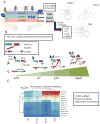
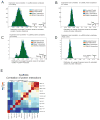
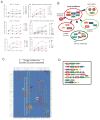
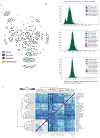
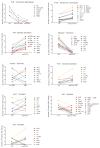
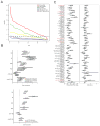
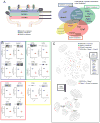
Similar articles
-
Molecular architecture of postsynaptic Interactomes.Cell Signal. 2020 Dec;76:109782. doi: 10.1016/j.cellsig.2020.109782. Epub 2020 Sep 14. Cell Signal. 2020. PMID: 32941943 Free PMC article. Review.
-
Identification of MAGUK scaffold proteins as intracellular binding partners of synaptic adhesion protein Slitrk2.Mol Cell Neurosci. 2020 Mar;103:103465. doi: 10.1016/j.mcn.2019.103465. Epub 2020 Jan 8. Mol Cell Neurosci. 2020. PMID: 31923461
-
Targeted tandem affinity purification of PSD-95 recovers core postsynaptic complexes and schizophrenia susceptibility proteins.Mol Syst Biol. 2009;5:269. doi: 10.1038/msb.2009.27. Epub 2009 May 19. Mol Syst Biol. 2009. PMID: 19455133 Free PMC article.
-
Essential contribution of the ligand-binding beta B/beta C loop of PDZ1 and PDZ2 in the regulation of postsynaptic clustering, scaffolding, and localization of postsynaptic density-95.J Neurosci. 2006 Jan 18;26(3):763-74. doi: 10.1523/JNEUROSCI.2489-05.2006. J Neurosci. 2006. PMID: 16421296 Free PMC article.
-
The postsynaptic organization of synapses.Cold Spring Harb Perspect Biol. 2011 Dec 1;3(12):a005678. doi: 10.1101/cshperspect.a005678. Cold Spring Harb Perspect Biol. 2011. PMID: 22046028 Free PMC article. Review.
Cited by
-
A unified resource and configurable model of the synapse proteome and its role in disease.Sci Rep. 2021 May 11;11(1):9967. doi: 10.1038/s41598-021-88945-7. Sci Rep. 2021. PMID: 33976238 Free PMC article.
-
Synaptic proteins associated with cognitive performance and neuropathology in older humans revealed by multiplexed fractionated proteomics.Neurobiol Aging. 2021 Sep;105:99-114. doi: 10.1016/j.neurobiolaging.2021.04.012. Epub 2021 Apr 24. Neurobiol Aging. 2021. PMID: 34052751 Free PMC article.
-
Molecular architecture of postsynaptic Interactomes.Cell Signal. 2020 Dec;76:109782. doi: 10.1016/j.cellsig.2020.109782. Epub 2020 Sep 14. Cell Signal. 2020. PMID: 32941943 Free PMC article. Review.
-
Monitoring protein communities and their responses to therapeutics.Nat Rev Drug Discov. 2020 Jun;19(6):414-426. doi: 10.1038/s41573-020-0063-y. Epub 2020 Mar 5. Nat Rev Drug Discov. 2020. PMID: 32139903 Review.
-
CNKSR2 interactome analysis indicates its association with the centrosome/microtubule system.Neural Regen Res. 2025 Aug 1;20(8):2420-2432. doi: 10.4103/NRR.NRR-D-23-01725. Epub 2024 May 17. Neural Regen Res. 2025. PMID: 39359098 Free PMC article.
References
-
- Collins MO, et al. Molecular characterization and comparison of the components and multiprotein complexes in the postsynaptic proteome. Journal of neurochemistry. 2006;97(Suppl 1):16–23. - PubMed
-
- Husi H, Ward MA, Choudhary JS, Blackstock WP, Grant SG. Proteomic analysis of NMDA receptor-adhesion protein signaling complexes. Nature neuroscience. 2000;3:661–669. - PubMed
MeSH terms
Substances
Grants and funding
LinkOut - more resources
Full Text Sources
Other Literature Sources
Molecular Biology Databases

